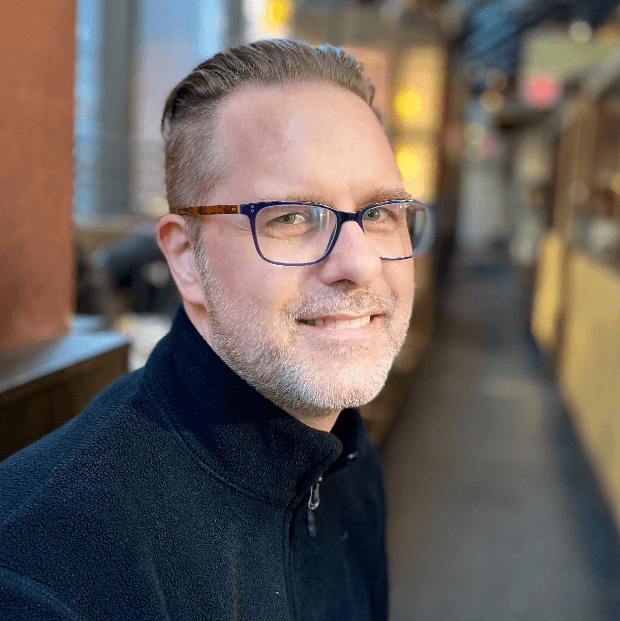
Companies are unique. (We were going to make a snowflake metaphor, but we respect you too much for that.) While this may not feel like a revelation, it’s important to recognize this seemingly obvious fact because most books, tweets, and listicles touting “best business practices” often treat companies as if they’re all the same. Want to create a strong and safe company culture? It’s as easy as grabbing a how-to book from an MBA’s bookshelf, implementing what it says, and congratulating yourself on being a great leader. Right?
Obviously, it’s not so simple. A startup that provides software for police is presumably quite different than a DTC hats for cats company. Given those differences, a startup’s approach to culture and inclusivity should reflect the company’s specific circumstances and environment.
As advocates for a tailored approach to company culture, we were excited to chat with Vice President of People at Public Safety Software Company, Mark43 — Steve Hoffman — to learn how he implemented specific practices at his company.
He shared advice for young companies without a dedicated People Ops leader, discussed navigating Slack and its many minefields, and talked about how Mark43 built a tailored framework to help employees navigate challenging situations, including harassment, while working closely with customers.
RP: So Steve, when’s the right time to bring in a People Operations leader?
SH: Well, when you have two employees, you should be thinking about it. Once you've developed culture and norms, it’s really hard to change them, which is why getting this right from the beginning is critical.
RP: Makes complete sense. But, realistically, People Ops isn’t likely to be the earliest hire. Any advice for small teams looking to be thoughtful on culture and talent who aren’t yet in the position to bring on a pro?
SH: A values exercise can be a high-impact way to start thoughtfully developing your culture, even without a full-time People Ops leader. I suggest that team members list the core values they want to see in their company and then come together to share and align on a few. These should be both accurate and aspirational.
If inclusivity isn’t one of them, it’s important to pause and ask why.
Another tip is to start measuring your values early on. While data can’t solve all the problems, if you aren’t looking at factors such as compensation of team members or their demographics, it’ll be very hard to address them.
Finally, it’s really important to consider integrating your company values in a thoughtful way into your hiring, promotion and performance review processes. This ensures that new employees and existing employees are aligned to your company values.
RP: When is a pro (like you) normally brought in?
SH: I usually come in around employee #150; but at Mark43, I was here at 86. This company and Founders had a strong commitment to investing in culture and a professional People Operations team.
RP: What if you’re at a company where there isn’t an open dialogue about culture. (This is obviously hypothetical, as Ethena’s culture is perfect…)
SH: I’ve seen relatively junior people address the lack of a conversation about culture. It doesn’t always work out, but sometimes someone from inside the team can jumpstart that conversation.
Otherwise, it can help to have an external perspective. That’s where employee survey tools can be great—anonymous data can help surface issues to leadership. Third-party professionals are also great resources to provide an objective view.
RP: Speaking of workplace culture… Slack usage in startups. Need I say more?
SH: *Sighs* Yes, some training here can really pay off. We talk with all our new hires about how to be thoughtful on Slack. It’s a great tool, but you have to be thoughtful in using it. I describe Slack as yelling in an open office floor plan. Nuance is hard, and you can get people riled up unintentionally.
RP: And if things get a little heated…?
For disagreements, I suggest taking an issue to a private channel. Explanations can sometimes come off as condescending, so it can be best to DM or explain in-person.
And then there are inclusivity considerations. New employees, for example, aren’t in on all the inside jokes. That doesn’t mean team members can’t reference them, but it’s helpful to realize what issues can make a culture cliquey.
RP: There’s definitely a fine line between tight-knit and cliquey. And it’s key to get the right balance. Once you do, how do you maintain those values with clients? Mark43 provides technology for public safety departments—how do you translate your workplace culture outside of your company walls? I’m assuming, from my time in the army, that Mark43’s start-up culture is pretty different than the culture at the public safety departments you work with.
SH: We proudly help public safety departments to do their work. A group of our employees will often be on site and work with police officers, for example; and that’s a very different environment. Our customers are very professional and respectful, but it’s been important for us to think about all situations.
Additionally, when we send someone on site, it can be intimidating; they’re customers and traditional authority figures.
Given this complexity, we thought it was important to develop an internal framework that helps our employees navigate tough situations.
RP: Prior to starting Ethena, I was (briefly) a consultant and interacted frequently with clients. I don’t recall ever getting advice on how to navigate the tricky situations that can happen in a client services industry, where client satisfaction really matters.
For example, what to do if I’m at a client dinner and the client starts asking about my personal life in a way that feels invasive? I’m sure there was a handbook somewhere, but what would have been really useful is a framework with a few easy-to-remember guidelines.
SH: Exactly right. Most of it is common sense, but we thought two things were really important:
- We co-created this framework with a customer to ensure it was realistic and addressed the specific situations of our industry.
- We share it with all our team members because most employees are going to be great advocates for themselves. But as a People Ops leader, it’s my job to ensure that all employees are set up for success. We have team members right out of school, for example, and they might not know what to do in a tough customer situation [like the one you mentioned]. So we didn’t want to put the onus on the employee. Our employees should have consistent experiences, and know that our obligation to keep them safe is more important than even our customer.
RP: It’s great to see you recognizing how challenging a client interaction can be, especially for a junior team member. Can you give an example of something in the framework?
SH: Sure. One thing we tell our employees is, if you feel uncomfortable in a situation, don’t put your personal life in the middle of it. By that, we mean you don’t need to bring in a line such as, “I’m married” because that can be even more uncomfortable. Instead, we advise team members to put the company in between, by saying something such as, “Our company has a policy where I report situations that make me feel uncomfortable.”
RP: Super interesting. When I was deployed to Afghanistan, I was advised to make up a whole backstory about how I had children (conveniently named after my brothers, so I wouldn’t forget their names). I think your policy is much more effective. Not only that, but it demonstrates Mark43’s commitment to its employees’ safety.
Thanks for sharing how you’ve thought about building an inclusive and effective company culture.
SH: Happy to!
Thanks to Steve Hoffman for taking the time to speak with us and for sharing his experience and insights. If you are a People Ops Leader or an industry professional who would like to connect with the Ethena team, please reach out to [email protected]. We’d love to hear from you!








